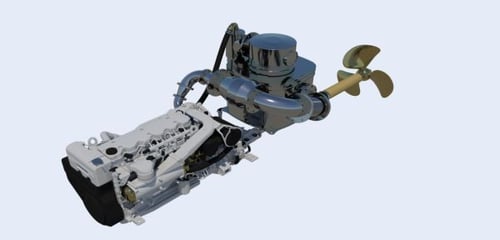
We have developed a simple and flexible system that meets the emission requirements south of 62 degrees latitude. As a consequence of the new requirements and lack of satisfactory solutions in the market, Frydenbø has developed a system is IMO Tier III complient.
The solution is a Selective Catalytic Reduction System (SCR) which we have developed together with our partner Eminox. The product has been named Frydenbø ATS (after treatment system), and is currently available on the market. It has been very important for us to create a system that is flexible, easy to adapt and of course meets the new emission requirements. The system consists of 4 main components, nox catalyst, tank with pump, mixer pipe and wet exhaust or dry exhaust elbow which can be adapted to most engines on the market.
What does this mean?
This means that diesel engines with an output of more than 130 kW installed on board ships built on or after 1 January 2021, and operating in the North Sea Emission Control Area (NSECA) on or after this date, must meet NOx Level III emission requirements as follows of the Environmental Safety Regulations § 12, cf. MARPOL Reg. VI/13.5.1.1.
NOx Level III requirements also apply to major conversions of diesel engines from 1 January 2021 or later on ships operating in NSECA on 1 January 2021 or later.
In this context, the term "major conversions" means the following:
1. the engine is replaced with a diesel engine or an additional diesel engine is installed, or
2. a significant change is made to the engine, as defined in the revised NOx code from 2008, or
3. the engine's maximum continuous power is increased by more than 10% compared to the maximum continuous power for which the engine was originally certified.
Changing to a diesel engine that is not exactly the same as the diesel engine it replaces
If a replacement diesel engine, with similar power output, that meets NOx Level III requirements is not commercially available on 1 January 2021 or later, cf. Environmental Safety Regulations § 12, cf. MARPOL Reg. VI/13.2.2, then the replacement diesel engine is not covered by NOx Level III requirements that apply in NSECA on or after 1 January 2021. Then NOx Tier II requirements apply.
The shipping company must document that it has searched for compatible NOx Level III engines and explain why the closest available engine in terms of size or performance is not suitable for installation on board the vessel. The search must include engines produced by manufacturers other than the manufacturer of the original engine. The documentation will be assessed by the Norwegian Maritime Directorate. The documentation and the Norwegian Maritime Authority's confirmation that the replacement engine must not meet NOx Level III requirements must be kept together with the replacement engine's EEIAP certificate.
Diesel engine installed in ships with a total engine output of less than 750 kW
A diesel engine with an output of more than 130 kW installed on a ship built on or after 1 January 2021 with a total engine output of less than 750 kW and to operate in NSECA must not meet NOx Tier III requirements, if the design or construction of the ship means that NOx Level III requirements cannot be met, cf. the environmental safety regulations § 12, cf. MARPOL Reg. VI/13.5.2.2.
Facts
Can be easily adapted to a wide range of engine types between 130-700kW. Meets new IMO Tier III regulations.